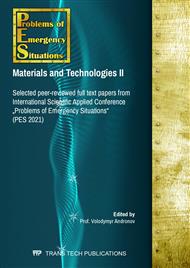[1]
Y. Dreval, V. Loboichenko, A. Malko, A. Morozov, S. Zaika, V. Kis. The Problem of Comprehensive Analysis of Organic Agriculture as a Factor of Environmental Safety, J. Environ. Clim. Technol. 24 (2020) 58–71.
DOI: 10.2478/rtuect-2020-0004
Google Scholar
[2]
Safety and Security Analysis: Investigative Report by NASA on Proposed EPA Hydrogen-Powered Vehicle Fueling Station. Assessment and Standards Division Office of Transportation and Air Quality U.S. Environment Protection Agency, EPA420-R-04-016 October 2004. 45 p.
Google Scholar
[3]
A. Kovalov, Y. Otrosh, O. Ostroverkh, O. Hrushovinchuk, O. Savchenko. Fire resistance evaluation of reinforced concrete floors with fire-retardant coating by calculation and experimental method. E3S Web of Conferences. 60, 00003 (2018). https://doi.org/10.1051/e3sconf/20186000003.
DOI: 10.1051/e3sconf/20186000003
Google Scholar
[4]
Y. Otrosh, A. Kovalov, O. Semkiv, I. Rudeshko, V. Diven. Methodology remaining lifetime determination of the building structures. MATEC Web of Conferences. 230, 02023 (2018). https://doi.org/10.1051/matecconf/201823002023.
DOI: 10.1051/matecconf/201823002023
Google Scholar
[5]
A. Kovalov, Y. Otrosh, M. Surianinov, T. Kovalevska. Experimental and Computer Researches of Ferroconcrete Floor Slabs at High-Temperature Influences. Materials Science Forum. 968 (2019) 361-367.
DOI: 10.4028/www.scientific.net/msf.968.361
Google Scholar
[6]
A. Kovalov, Y. Otrosh, S. Vedula, О. Danilin, T. Kovalevska. Parameters of fire-retardant coatings of steel constructions under the influence of climatic factors. Scientific Bulletin of National Mining University. 3 (2019) 46-53.
DOI: 10.29202/nvngu/2019-3/9
Google Scholar
[7]
Y. Otrosh, M. Surianinov, A. Golodnov, O. Starova. Experimental and Computer Researches of Ferroconcrete Beams at High-Temperature Influences. Materials Science Forum. 968 (2019) 355-360.
DOI: 10.4028/www.scientific.net/msf.968.355
Google Scholar
[8]
Y. Otrosh, O. Semkiv, E. Rybka, A. Kovalov. About need of calculations for the steel framework building in temperature influences conditions. Materials Science and Engineering. 708 (2019) 012065.
DOI: 10.1088/1757-899x/708/1/012065
Google Scholar
[9]
M. Surianinov, V. Andronov, Y. Otrosh, T. Makovkina, S. Vasiukov. Concrete and Fiber Concrete Impact Strength. In Materials Science Forum. Trans Tech Publications Ltd. 1006 (2020) 101-106.
DOI: 10.4028/www.scientific.net/msf.1006.101
Google Scholar
[10]
Y. Skob, M. Ugryumov, Y. Dreval. Numerical Modelling of Gas Explosion Overpressure Mitigation Effects. Materials Science Forum. 1006 (2020) 117-122.
DOI: 10.4028/www.scientific.net/msf.1006.117
Google Scholar
[11]
H. Schneider. Large Scale Experiments: Deflagration and Deflagration to Detonation within a partial Confinement similar to a lane. Proc. of International Conference on Hydrogen Safety. Pisa (Italy). 2005. 10 p.
Google Scholar
[12]
Y. Skob, M. Ugryumov, E. Granovskiy, Numerical Evaluation of Probability of Harmful Impact Caused by Toxic Spill Emergencies, J. Environ. Clim. Technol. 23 (2019) 1-14.
DOI: 10.2478/rtuect-2019-0075
Google Scholar
[13]
Y. Skob, M. Ugryumov, E. Granovskiy. Numerical assessment of hydrogen explosion consequences in a mine tunnel, Int. J. Hydrog. Energy. 2020. https://doi.org/10.1016/j.ijhydene .2020.09.067.
DOI: 10.1016/j.ijhydene.2020.09.067
Google Scholar
[14]
E. A. Granovskiy, V. A. Lyfar, Yu. A. Skob, M. L. Ugryumov, Computational Modeling of Pressure Effects from Hydrogen Deflagrations // Proc. of 2-nd International Conference on Hydrogen Safety. San Sebastian (Spain). 2007. 15 p.
Google Scholar


